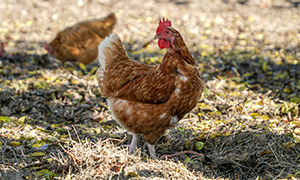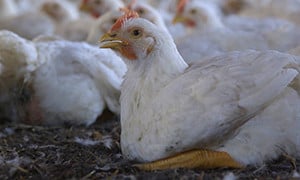
Facts about Chickens
Common name: Chicken
Scientific name: Gallus gallus domesticus
Distribution: Worldwide
Image credit: Valerie Kuypers / World Animal Protection
Were you aware that all domestic chickens are descended from wild junglefowl that are native to Southern Asia but they have been living with humans for more than 5,000 years? Here are some more chicken facts that will blow your mind.
Chickens are way more intelligent and sensitive than many people think. These clever creatures are the closest living relatives to the Tyrannosaurus Rex.
Chickens also have very interesting bone structures; they have more bones in their necks than giraffes and all their bones are very light. Some of their bones are hollow and called ‘pneumatic bones’. They actually form part of chickens’ respiratory systems and work with the lungs to help them breathe.
Like people, and many other animals, different chickens have different personalities. Some birds are bold and feisty, others are shy and cautious. These personalities are key to helping chickens arrange themselves and their flock into a ‘pecking order’.
Chickens also have brilliant eyesight. They can see both close-up objects and panorama views clearly and can identify different colours, which helps them search for food. Interestingly they can distinguish people they know from strangers.
Chickens explore great distances foraging for food, scratching at the ground to reveal seeds and insects. They will warn each other of potential danger and communicate with over 30 different calls. A rooster will often call to hens when he has discovered food, and hens will do the same to help their chicks eat.

Chickens just for eggs
Layer hens have been specifically selected for their high egg production.
Each hen produces approximately 300 eggs a year with over 550 million dozen eggs laid in Australia annually.
There are approximately 21 million layer hens in Australia, 9 million of which are housed in battery cages with little more than an A4 piece of paper – that’s half of all layer hens.
Hens in factory farms will live for around 72 weeks until they are considered unproductive or 'spent'.
 Layer hen in a farm yard.
Layer hen in a farm yard.
Chickens used for meat
Broilers or meat chickens have been genetically selected to grow and grow, reaching their ‘slaughter weight’ as fast as possible. And it's this rapid growth, that presents the biggest welfare challenges. A 30g chick can reach slaughter weight, around 2kg, in as little as 6 weeks.
That’s the equivalent of a 3kg newborn human baby reaching 300 kilograms in 2 months.
Chicken is one of the world’s most popular meats with around 70 billion chickens reared for meat each year. Each year more than 700 million chickens are produced for meat in Australia and most are factory farmed in sheds with more than 40,000 birds.
 Approximately 28 day old broiler (meat) chicken in a commercial indoor system.
Approximately 28 day old broiler (meat) chicken in a commercial indoor system.
What is the problem with factory farming chickens
Globally about two-thirds of chickens reared for meat each year (40 billion birds) are kept in factory farming systems made up of huge, crowded sheds, or cramped cages – often with no room to move, natural light or fresh air. These chickens suffer at every stage of their short lives.
Chickens are bred to grow unnaturally large and unnaturally quickly. Due to their overgrown size and growth rate, these chickens suffer from conditions such as:
- Painful lameness
- Overworked hearts and lungs
- Wounds including skin sores and burns
As farms become increasingly industrialised to meet the growing global demand for chicken meat, chickens are bred to grow much faster than they traditionally did. This can come at an enormous cost to the welfare of the birds.



An industrial chicken shed can hold tens of thousands of birds. This extreme overcrowding can make it difficult for chickens to move or behave naturally, unable to peck or spread their wings.
Many industrial chicken sheds are bare except for lines of food and water dispensers. Chickens are often unable to perform natural behaviours, such as perching, foraging, exploring and dust-bathing. These activities would normally keep them active and healthy.
Chickens use vision as their main sense, and their colour vision is very well developed and designed to be used in brightly lit conditions. Despite this, most industrially farmed chickens spend their whole lives in gloomy, closed sheds without any natural light. This means that the chickens tend to move around less, which can lead to leg problems.
The unnatural conditions in factory farms deny chickens their instinctual behaviours and can cause extreme psychological and physical suffering.

How we are helping chickens on factory farms
Every day, millions of chickens experience physical and psychological suffering in the name of profit. Without changes from producers, consumers and retailers, this style of industrial farming will expand in order to meet the huge demand for cheap meat across the globe. But it doesn’t have to be like this.

We believe all animals deserve a good life. One that doesn’t hurt. Our campaign’s demands are technically detailed and vary from country to country, but the focus of our asks can be broadly summarised as follows:
- The use of slower-growing chicken breeds who grow at a more natural rate
- Chickens have enough room to move around and exhibit important natural behaviours
- Chickens are able to enjoy proper enrichment that keeps them healthy and active
- Chickens benefit from natural light and proper periods of darkness for rest
- No use of cages
- A reduction in the use of antibiotics in farm animals - enabled by moving to higher welfare farming systems
With our supporters’ help, we pushed Burger King UK, Nando’s UK and KFC in six European countries to commit to higher chicken welfare by joining the Better Chicken Commitment which will give better lives to tens of millions of chickens. Our work to move KFC Australia and KFC India to do the same continues.
Chicken producers must provide more space, stimuli to keep birds active, natural lighting and use slower growing breeds to improve the physical and mental wellbeing of the chickens on their farms.
Our chicken welfare report, 'Valuing Higher Welfare Chicken' report, found that producing chicken in better conditions is far cheaper than previously believed. The research in Brazil, China, USA and Thailand means that billions of chickens around the world could suffer less as cost can no longer be used as an excuse by restaurants, retailers and producers. The improvements proposed in the report to give intensively farmed chickens better lives can be easily introduced to most existing systems.
How you can help chickens
You can help chickens and other farm animals live a better life by making informed decisions at the grocery store.
Reduce the amount of chicken meat you purchase and only buy slow-grown, high-welfare meat or genuine free-range eggs when you choose to eat it.


Donate to protect chickens
In industrial farming, a chick may go her entire life without seeing sunlight. Together, we can give chickens lives worth living.
Call on KFC New Zealand to give chickens better lives
Call on KFC to sign the Better Chicken Commitment and put a stop to the cruelty these creatures experience.

The Pecking Order
Read our 'Pecking Order' report and find out how global fast-food brands are responding to the chicken crisis.
Latest farming news
-

ABP cuts off factory farming investments
News
ABP, one of the largest pension funds in the world, was inspired to adopt an animal welfare policy...
-

WATCH: New Zealanders speak out to #ProtectTheBan
News
Listen to what members of the public had to say about the Government’s plans to repeal the ban...
-

Maned wolves in Brazil protected from drowning
News
Your support is making a world of difference in protecting maned wolves like Barão and his mate Savana...
-

Over 57,000 signatures to #ProtectTheBan on live exports
News
Thank you for raising your voice to protect animals in Aotearoa New Zealand from returning to the barbaric...
